GMC YUKON XL 2007 Manual PDF
Manufacturer: GMC, Model Year: 2007, Model line: YUKON XL, Model: GMC YUKON XL 2007Pages: 608, PDF Size: 3.01 MB
Page 71 of 608
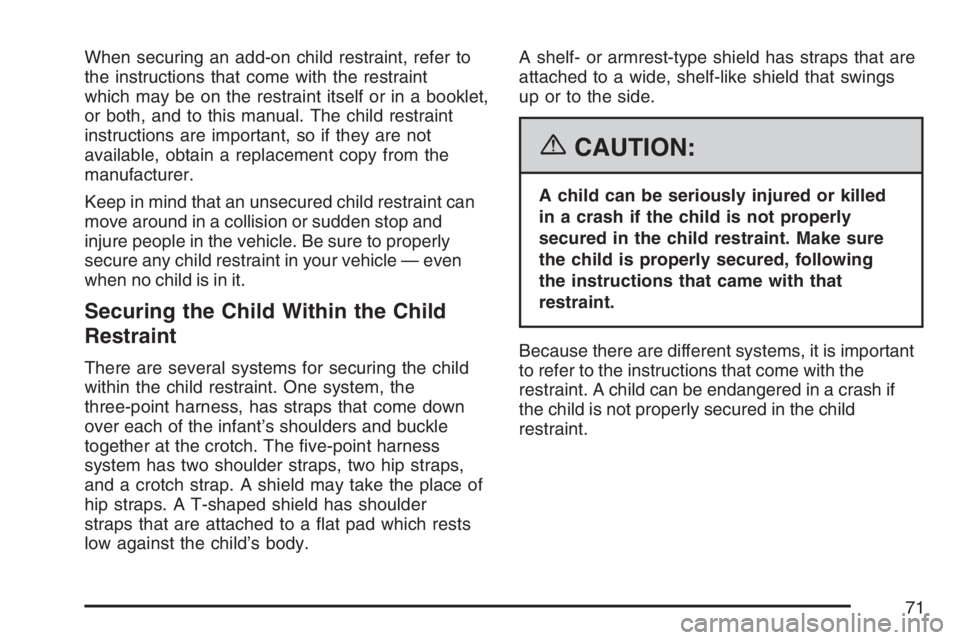
When securing an add-on child restraint, refer to
the instructions that come with the restraint
which may be on the restraint itself or in a booklet,
or both, and to this manual. The child restraint
instructions are important, so if they are not
available, obtain a replacement copy from the
manufacturer.
Keep in mind that an unsecured child restraint can
move around in a collision or sudden stop and
injure people in the vehicle. Be sure to properly
secure any child restraint in your vehicle — even
when no child is in it.
Securing the Child Within the Child
Restraint
There are several systems for securing the child
within the child restraint. One system, the
three-point harness, has straps that come down
over each of the infant’s shoulders and buckle
together at the crotch. The �ve-point harness
system has two shoulder straps, two hip straps,
and a crotch strap. A shield may take the place of
hip straps. A T-shaped shield has shoulder
straps that are attached to a �at pad which rests
low against the child’s body.A shelf- or armrest-type shield has straps that are
attached to a wide, shelf-like shield that swings
up or to the side.
{CAUTION:
A child can be seriously injured or killed
in a crash if the child is not properly
secured in the child restraint. Make sure
the child is properly secured, following
the instructions that came with that
restraint.
Because there are different systems, it is important
to refer to the instructions that come with the
restraint. A child can be endangered in a crash if
the child is not properly secured in the child
restraint.
71
Page 72 of 608
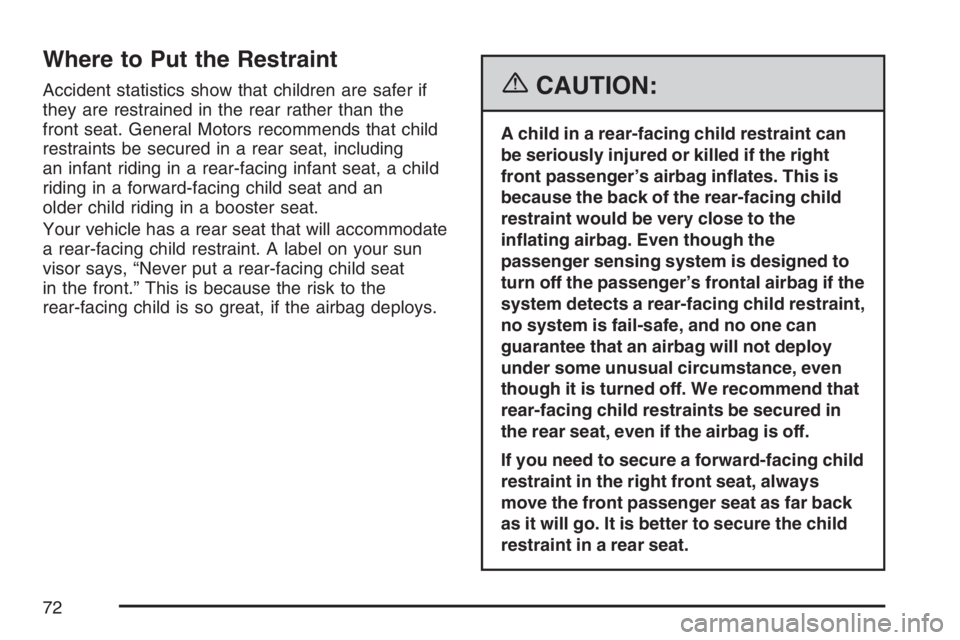
Where to Put the Restraint
Accident statistics show that children are safer if
they are restrained in the rear rather than the
front seat. General Motors recommends that child
restraints be secured in a rear seat, including
an infant riding in a rear-facing infant seat, a child
riding in a forward-facing child seat and an
older child riding in a booster seat.
Your vehicle has a rear seat that will accommodate
a rear-facing child restraint. A label on your sun
visor says, “Never put a rear-facing child seat
in the front.” This is because the risk to the
rear-facing child is so great, if the airbag deploys.{CAUTION:
A child in a rear-facing child restraint can
be seriously injured or killed if the right
front passenger’s airbag in�ates. This is
because the back of the rear-facing child
restraint would be very close to the
in�ating airbag. Even though the
passenger sensing system is designed to
turn off the passenger’s frontal airbag if the
system detects a rear-facing child restraint,
no system is fail-safe, and no one can
guarantee that an airbag will not deploy
under some unusual circumstance, even
though it is turned off. We recommend that
rear-facing child restraints be secured in
the rear seat, even if the airbag is off.
If you need to secure a forward-facing child
restraint in the right front seat, always
move the front passenger seat as far back
as it will go. It is better to secure the child
restraint in a rear seat.
72
Page 73 of 608

Do not use child restraints in the center front seat
position. The restraints will not work properly.
Wherever you install it, be sure to secure the child
restraint properly.
Keep in mind that an unsecured child restraint can
move around in a collision or sudden stop and
injure people in the vehicle. Be sure to properly
secure any child restraint in your vehicle — even
when no child is in it.
Lower Anchors and Tethers for
Children (LATCH)
Your vehicle has the LATCH system. The LATCH
system holds a child restraint during driving or
in a crash. This system is designed to make
installation of a child restraint easier. The LATCH
system uses anchors in the vehicle and
attachments on the child restraint that are made
for use with the LATCH system
Make sure that a LATCH-compatible child restraint
is properly installed using the anchors, or use the
vehicle’s safety belts to secure the restraint,
following the instructions that came with that
restraint, and also the instructions in this manual.
When installing a child restraint with a top tether,you must also use either the lower anchors or the
safety belts to properly secure the child restraint.
A child restraint must never be attached using only
the top tether and anchor.
In order to use the LATCH system in your vehicle,
you need a child restraint that has LATCH
attachments. The child restraint manufacturer will
provide you with instructions on how to use
the child restraint and its attachments. The
following explains how to attach a child restraint
with these attachments in your vehicle.
Your vehicle has lower anchors and top tether
anchors. Your child restraint may have lower
attachments and a top tether.
Not all vehicle seating positions or child restraints
have lower anchors and attachments or top tether
anchors and attachments.
73
Page 74 of 608
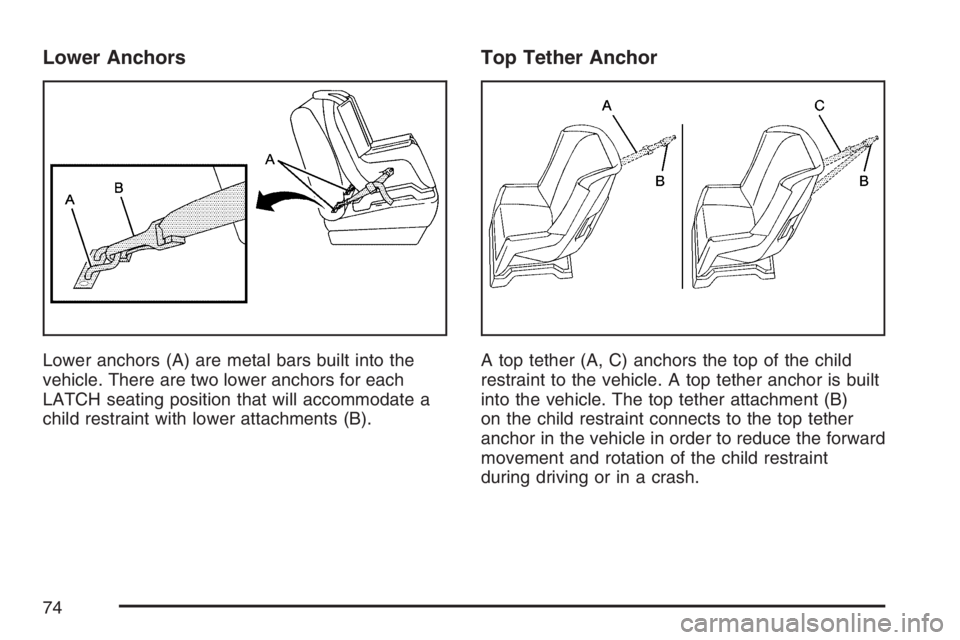
Lower Anchors
Lower anchors (A) are metal bars built into the
vehicle. There are two lower anchors for each
LATCH seating position that will accommodate a
child restraint with lower attachments (B).
Top Tether Anchor
A top tether (A, C) anchors the top of the child
restraint to the vehicle. A top tether anchor is built
into the vehicle. The top tether attachment (B)
on the child restraint connects to the top tether
anchor in the vehicle in order to reduce the forward
movement and rotation of the child restraint
during driving or in a crash.
74
Page 75 of 608
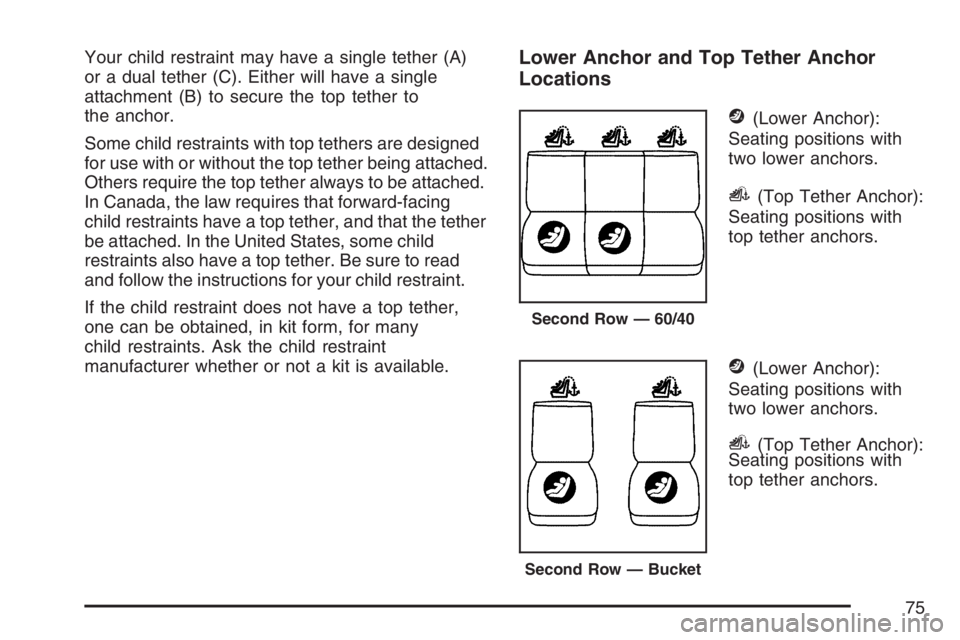
Your child restraint may have a single tether (A)
or a dual tether (C). Either will have a single
attachment (B) to secure the top tether to
the anchor.
Some child restraints with top tethers are designed
for use with or without the top tether being attached.
Others require the top tether always to be attached.
In Canada, the law requires that forward-facing
child restraints have a top tether, and that the tether
be attached. In the United States, some child
restraints also have a top tether. Be sure to read
and follow the instructions for your child restraint.
If the child restraint does not have a top tether,
one can be obtained, in kit form, for many
child restraints. Ask the child restraint
manufacturer whether or not a kit is available.Lower Anchor and Top Tether Anchor
Locations
j(Lower Anchor):
Seating positions with
two lower anchors.
i(Top Tether Anchor):
Seating positions with
top tether anchors.
j(Lower Anchor):
Seating positions with
two lower anchors.
i(Top Tether Anchor):
Seating positions with
top tether anchors.
Second Row — 60/40
Second Row — Bucket
75
Page 76 of 608
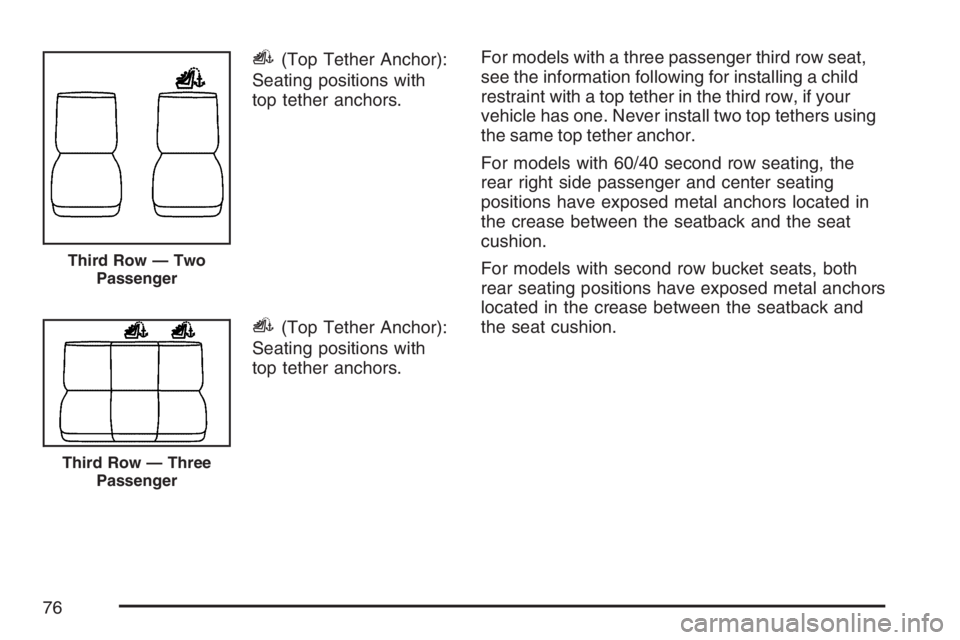
i(Top Tether Anchor):
Seating positions with
top tether anchors.
i(Top Tether Anchor):
Seating positions with
top tether anchors.For models with a three passenger third row seat,
see the information following for installing a child
restraint with a top tether in the third row, if your
vehicle has one. Never install two top tethers using
the same top tether anchor.
For models with 60/40 second row seating, the
rear right side passenger and center seating
positions have exposed metal anchors located in
the crease between the seatback and the seat
cushion.
For models with second row bucket seats, both
rear seating positions have exposed metal anchors
located in the crease between the seatback and
the seat cushion.
Third Row — Two
Passenger
Third Row — Three
Passenger
76
Page 77 of 608
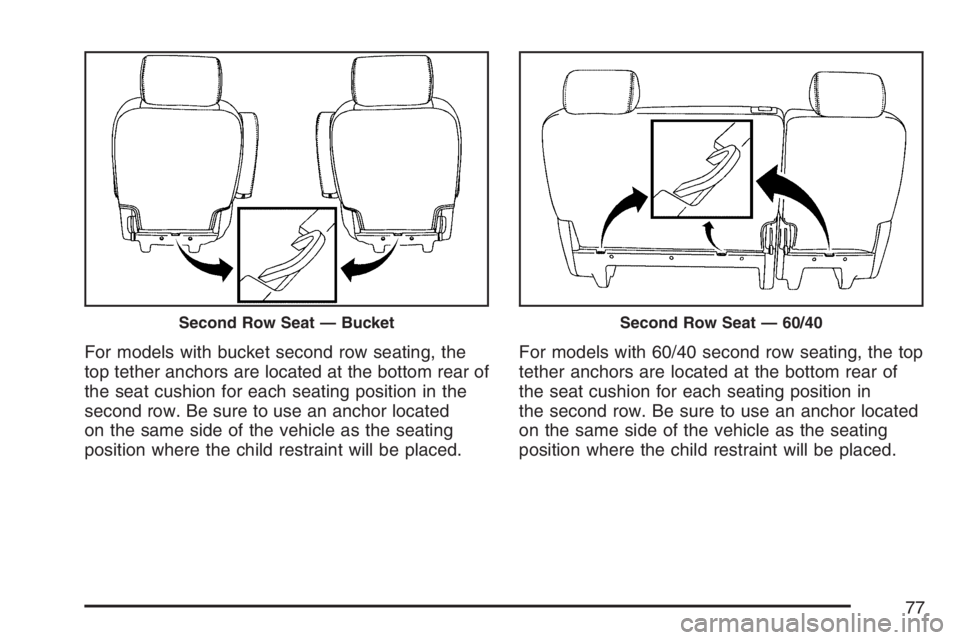
For models with bucket second row seating, the
top tether anchors are located at the bottom rear of
the seat cushion for each seating position in the
second row. Be sure to use an anchor located
on the same side of the vehicle as the seating
position where the child restraint will be placed.For models with 60/40 second row seating, the top
tether anchors are located at the bottom rear of
the seat cushion for each seating position in
the second row. Be sure to use an anchor located
on the same side of the vehicle as the seating
position where the child restraint will be placed.
Second Row Seat — BucketSecond Row Seat — 60/40
77
Page 78 of 608
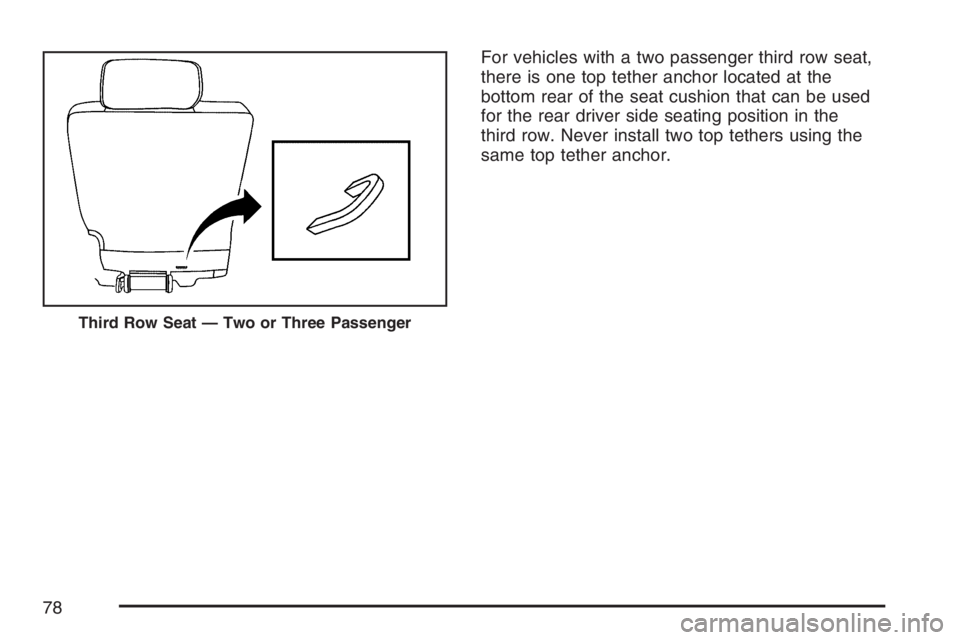
For vehicles with a two passenger third row seat,
there is one top tether anchor located at the
bottom rear of the seat cushion that can be used
for the rear driver side seating position in the
third row. Never install two top tethers using the
same top tether anchor.
Third Row Seat — Two or Three Passenger
78
Page 79 of 608
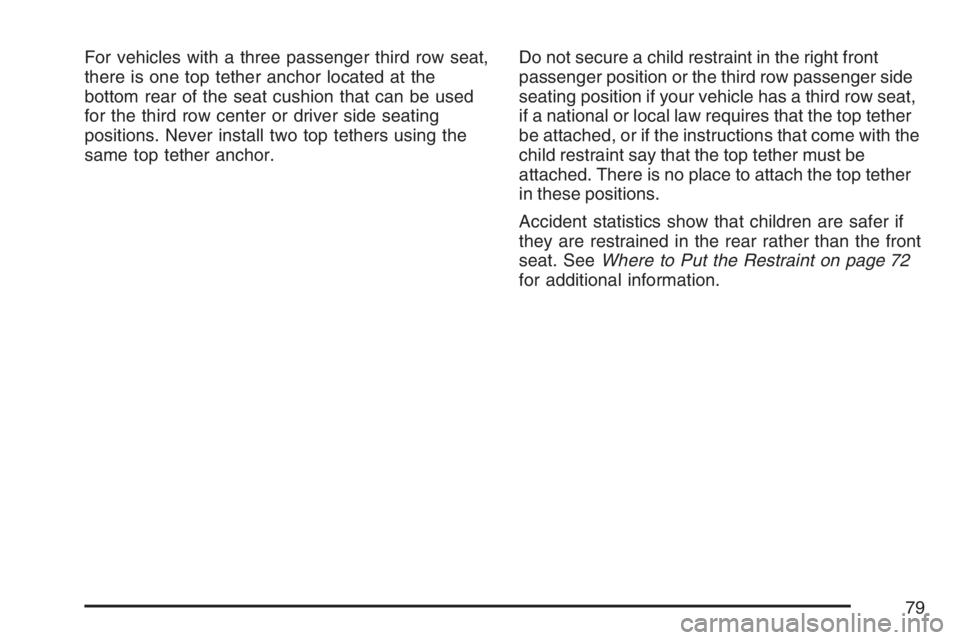
For vehicles with a three passenger third row seat,
there is one top tether anchor located at the
bottom rear of the seat cushion that can be used
for the third row center or driver side seating
positions. Never install two top tethers using the
same top tether anchor.Do not secure a child restraint in the right front
passenger position or the third row passenger side
seating position if your vehicle has a third row seat,
if a national or local law requires that the top tether
be attached, or if the instructions that come with the
child restraint say that the top tether must be
attached. There is no place to attach the top tether
in these positions.
Accident statistics show that children are safer if
they are restrained in the rear rather than the front
seat. SeeWhere to Put the Restraint on page 72
for additional information.
79
Page 80 of 608
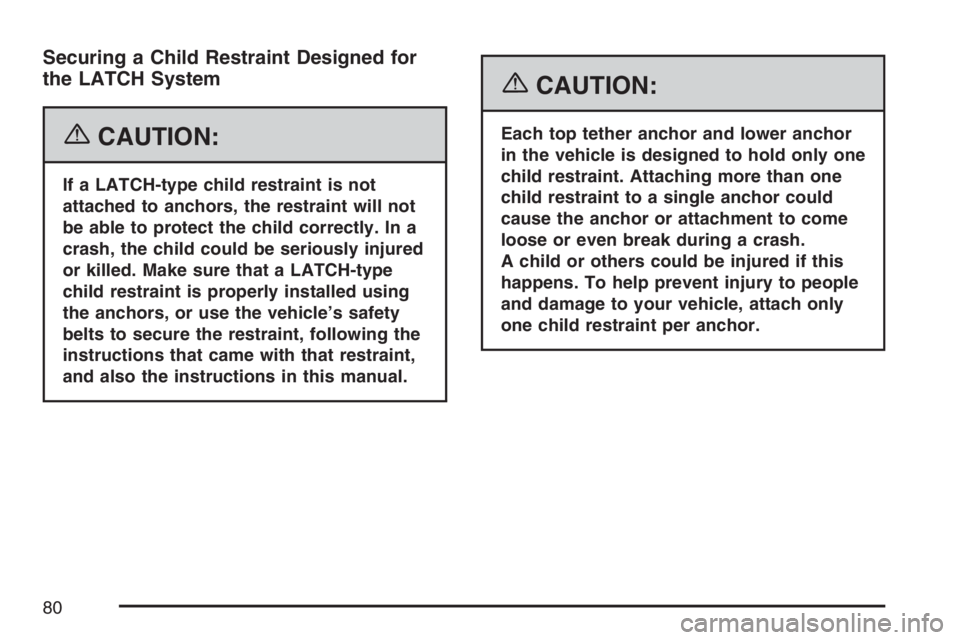
Securing a Child Restraint Designed for
the LATCH System
{CAUTION:
If a LATCH-type child restraint is not
attached to anchors, the restraint will not
be able to protect the child correctly. In a
crash, the child could be seriously injured
or killed. Make sure that a LATCH-type
child restraint is properly installed using
the anchors, or use the vehicle’s safety
belts to secure the restraint, following the
instructions that came with that restraint,
and also the instructions in this manual.
{CAUTION:
Each top tether anchor and lower anchor
in the vehicle is designed to hold only one
child restraint. Attaching more than one
child restraint to a single anchor could
cause the anchor or attachment to come
loose or even break during a crash.
A child or others could be injured if this
happens. To help prevent injury to people
and damage to your vehicle, attach only
one child restraint per anchor.
80